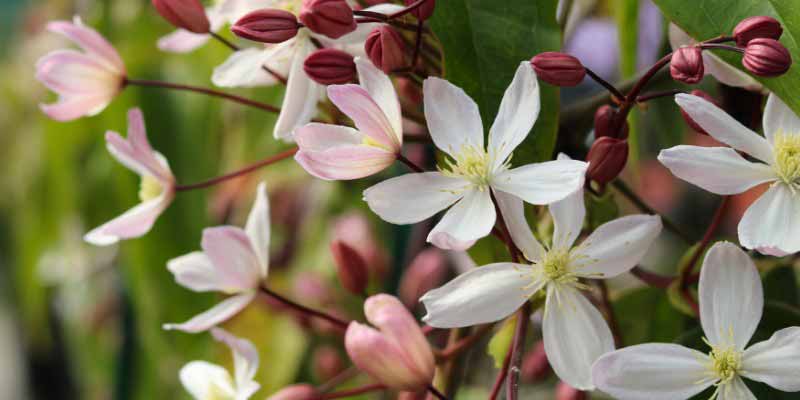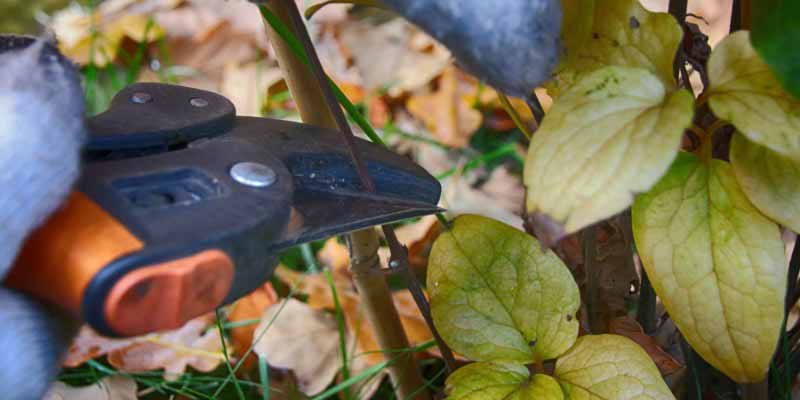Winter-flowering clematis, such as Clematis armandii or Clematis cirrhosa, are invaluable for brightening gardens in winter with their delicate flowers. They produce cascades of scented flowers sometimes from November onwards and are ideal for covering a trellis, wall, fence or bush. Moderately hardy, they cope poorly with very cold winters but often tolerate dry, hot summers once well established. Well-executed pruning helps maintain vigour and flowering. Here’s how to proceed!
Which clematis are winter-flowering?
Less well known than spring- or summer-flowering clematis, winter-flowering clematis often begin to flower from November and can continue until February–March, depending on variety and climate. Their flowers are generally bell- or star-shaped and occur in a range of colours, from pure white through pink to violet and deep purple. Many varieties emit a delicate, sweet scent. These are evergreen lianas whose foliage remains green even in winter. These clematis are relatively hardy and can withstand temperatures around -10 to -12°C. They are used to dress all kinds of structures, preferably planted in sun and sheltered from wind. Among best-known winter clematis varieties are:
- Clematis cirrhosa: Very popular, producing an abundant display of small white or pink bell-shaped flowers.
- Clematis armandii: Valued for its large, fragrant white flowers.
- Clematis montana : Although its flowering is mainly springtime, some varieties may begin to flower from late winter.

Should I prune my winter-flowering clematis?
Winter-flowering clematis bloom on last year’s wood. They can quite well do without pruning. Heavy or rough pruning risks removing flower buds already formed and, consequently, considerably reducing or even cancelling the following winter’s flowering. These winter-flowering clematis require very light pruning to remove dried or damaged stems and to shorten slightly those that bore flowers. By removing dead branches, weak stems and by opening up the plant, you allow light and air to circulate more freely. This limits disease development and promotes the emergence of new shoots. Winter-flowering clematis can become invasive and produce a lot of dead wood or cumbersome stems.
When to prune winter-flowering clematis?
It is important to prune at the right time or you may end up with a clematis that does not flower! The ideal time to prune a winter-flowering clematis is after flowering, around May, or in summer. A light maintenance pruning is sufficient, but not necessarily every year. You can spread pruning over several years to avoid excessively stressing the plant.

How to prune a winter-flowering clematis step by step?
Required equipment
To start, equip yourself with sharp, disinfected tools to avoid spreading disease. To prune your winter-flowering clematis, you will need:
- an pruning shear
- gardening gloves to protect your hands
Maintenance pruning
Winter clematis do not require drastic pruning. They are among the easiest to maintain. A simple maintenance pruning carried out every other year may suffice. Limit yourself to removing the essentials.
- Gently untangle the stems : Separate stems from each other, taking care not to break them.
- Remove ties used for training by cutting them with a pruning shear.
- Remove any overly dense or badly positioned branches to improve air and light circulation.
- Identify the current-year stems : These are the thinnest, most recent stems that have flowered. Cut them to about 30–50 cm from the soil, roughly 3 nodes. Always cut above a bud or a new shoot.
- Cut back all dead, dry branches and weak shoots to soil level.
- The later the flowering, the more you can cut short (down to 30 cm from soil). This severe pruning will stimulate growth of new stems.
- If your clematis is very dense or ageing, you can cut back some older branches by about one third, but avoid cutting them too short.

































Comments